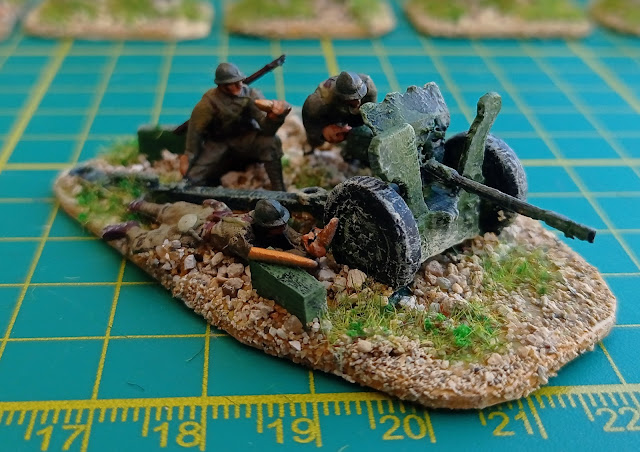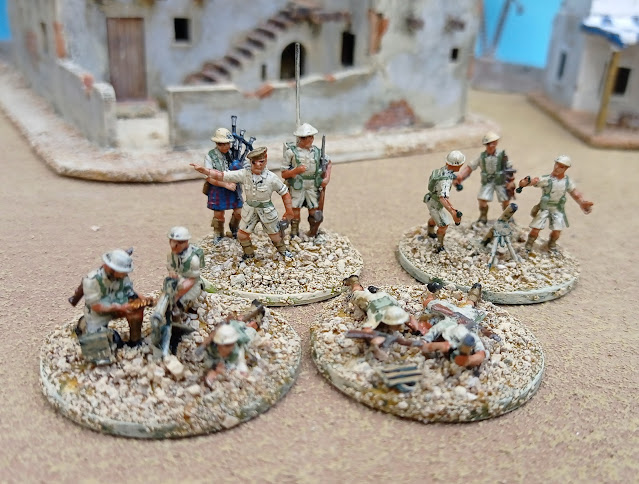This a wargaming place were you can see a growing collection of miniatures and terrain of many historical periods in 20mm (but also a few 10mm,15mm and 28mm) started when I was 10 yo. At the moment it has several tens of thousands of miniatures from foot figures to Destroyers. Occasionally there are some war movie critics and some travel to military sites. My family considers it the best wargaming site in the World even if it is the only one they know. More on @joaopeixoto5249 YouTube Channel.
Wednesday, 31 August 2022
The Soviet Tank Corps, Kursk 1943, for Rapid Fire rules and 20mm size
Monday, 29 August 2022
Rapid Fire! Western Desert 1940-43 in 20mm - First battalions of Australians
Two Australian Infantry battalions get ready to defend the bridge at the Lybian Wadi of Al-Kangaroo. These are my first Australian Infantry units I´ve ever painted even if I collected and stored them for many years. A problem with the Airfix, Revell and Esci figures was the lack of support weapons but you can easily convert them. This issue was solved recently by StreletsR releasing a box with support weapons (and also another one with rifle-armed figures).
Dressed in Mediterranean uniforms they are essential for the North African campaigns as well as Italy. In the recent leaked information from the Rapid Fire HQ we all will be forced to make Crete's Mercury operation (I mean, Masters know, right?) and that was also another push for me to paint and model these. Also the great articles by Mark Piper on the Greek campaign and other Mediterranean action also boosted this idea.
The infantry companies are (L to R) Airfix copy; Esci; Esci, Revell; Esci; Revell; Revell and Airfix copy. The mix of uniforms makes this units very versatile. The bush hat should have been replaced by the steel helmet but like this they really look like Australians. This is the principle I also followed for the Hindu and Scottish infantry to make them look their specific origin.
In the first picture you can find also some Airfix copies with helmets as I used its heads for the Portuguese campaign in Mozambique 1895. The Airfix copies were used here as they are true 1/72nd figures and go along very well with the other mentioned brands while the original are 1/76th and distinctively smaller.
Now for the bridge. Of course its not intended for NA but for Northern Europe, with France/Belgium 1940 and Market Garden as prime targets. Its a 1/72nd scale model that came from Aliexpress and it resembles pretty much the 28mm canal bridge by Arcane, probably being the same just resized.
This was my first MDF kit but, after watching a nice YouTube video, you find its making very simple:
1- Take out all pieces with a X-acto and glue them with Super Glue.
2- Apply diluted PVA glue all over in order to seal the wood.
3- Apply your normal primer and its ready to paint.
Monday, 22 August 2022
The French DI/DIM for the 1940 campaign in 20mm and for Rapid Fire! war...
Sunday, 21 August 2022
Rapid Fire! France 1940 in 20mm - The 9th French Infantry Battalion of the DI/DIM and the last few 25mm AT guns
Friday, 5 August 2022
Rapid Fire! Western Desert 1940-43 in 20mm - First Scottish battalion
A battalion of Scottish infantry prepares to defend the small Lybian village of Ras-Al-Sturgeon on the news of the Axis advance.
For many years I wanted some Scots for the desert. Recently I read that the 4th Indian Infantry Division had several battalions of Scottish infantry fueling my interest in having a few of them. In fact you can use the normal British outfit as most of the Commonwealth and that includes the steel helmet for Scots, Australians, Indians and others. But, by using plenty of figures with the Tam o' shanter as headdress, you have the Scottish soldiers clearly identified (the kilt saw almost no use). I´m using the same principle for Indian, Australian and others as all these are cheap plastic that I have in plenty for many years.
The British in the Desert 1940-43, for Rapid Fire! rules and in 20mm size
This time there is no particular division but different pools of models that enables you to play most of the actions described on both RF Western Desert supplements and in the many PDFs available in the RF site. The models are mostly plastics (Airfix, PSC, Fujimi, Hasegawa, S-Models, Matchbox, Revell and Esci), die-cast (Altaya), 3d prints (Minigeneral) and resin (Frontline Wargaming). The model of Monty's Caravan ( a british truck with an Italian body) is Matchbox and not Airfix and I said on the video.




























